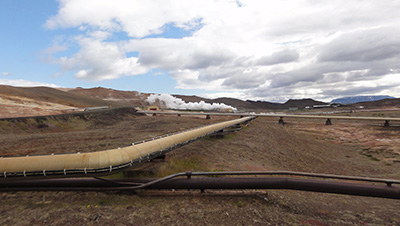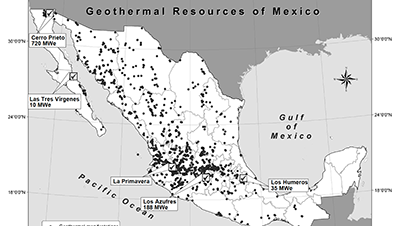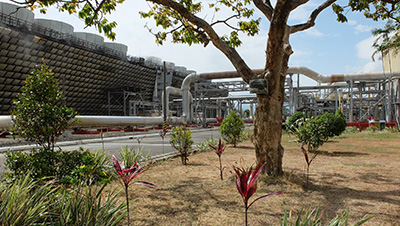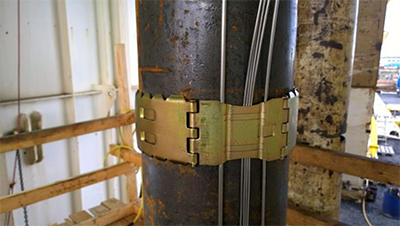
Small-Scale Geothermal Developments – Agriculture
April 8, 2019
Geothermal Country Overview: Indonesia
April 12, 2019Geophysical Mapping in Geothermal Energy: Part 2

Continuing from last week, we will look at indirect (structural) geophysical methods. These methods focus on geological parameters that indicate or reveal things important for understanding a geothermal system. These methods are focused on magnetic, gravity and seismic measurements.
Magnetic methods are widely used in geothermal exploration and focus on mapping changes in magnetism related to the distribution of magnetic minerals. Two main types of magnetism exist- Induced and remanent/permanent magnetization. The former is created by earth’s ambient magnetic field and the latter dominates in igneous rocks based on its properties and history. It is typically used to locate hidden intrusive rocks and the estimation of their depth. It is also used to trace faults. Airborne magnetic surveys are often employed to map near-surface alteration and iron-rich volcanic rocks. The data is often represented as contour or profile maps.
Studies in British Columbia, Canada used drones to carry out magnetic surveys earlier this year. The magnetic method was used to identify a deep geothermal source of > 1200 m below the surface during the reconnaissance of high potential geothermal resources in Mahallat, Iran.
 Image 1: Residual magnetic field of Mahallat, Iran (From Mohammadzadeh-Moghaddam, M., 2012)
Image 1: Residual magnetic field of Mahallat, Iran (From Mohammadzadeh-Moghaddam, M., 2012)
Gravity measurements detect lithologies of different densities. For geothermal exploration and development, gravity methods are used to map fault and dyke zones, dense intrusions and alterations (due to thermal effects) as well as volcano or basin geometry. Gravity maps are typically referred to Bouguer gravity anomaly map. More recently it has been used in measuring mass extraction in geothermal systems during production. A great example can be seen from geophysical studies carried out in the Olkaria geothermal field, Kenya.
 Image 2: Bouguer gravity distribution around the Olkaria geothermal field, Kenya (From Mariita, N.O., 2011)
Image 2: Bouguer gravity distribution around the Olkaria geothermal field, Kenya (From Mariita, N.O., 2011)
Seismic methods measure sound velocity distribution in the earth and the attenuation of sound waves. We make a distinction between active and passive measurements. The former uses external sources to generate sound waves and the former uses naturally occurring seismic activity in the earth. Active measurements provide data on the density of rocks, porosity, texture, boundaries and discontinuities, fluid-filled zones and possibly temperature. Passive seismic is used to map active faults and permeable zones. Seismic methods are rarely used in conventional geothermal settings (volcanic areas) due to poor results. However, it has been useful in specific structural settings (graben and basin) and during exploration in sedimentary hosted geothermal systems. This includes geothermal areas in Larderello-Travale (Italy), The Geysers, (USA), New Zealand, Mexico and Japan.
Geophysical methods are often combined (two or more) when carrying out exploration and development of a potential geothermal field. Popular combinations include magnetic and thermal mapping; magnetotellurics (MT) and gravity methods; or all of them, including transient electromagnetic (TEM). Studies in the Olkaria, geothermal field, Kenya, used all of the above methods in the exploration, development, and production of the resource. It’s good to note that it is challenging to tell from geophysical data alone whether or not a geothermal area is worth developing. It is essential to combine geophysics with geology, geochemistry and borehole data (where available) in order to obtain significant information on the geothermal system.
This concludes Geophysical Mapping, Part 2, of our #GeothermalFactsandStats #Mapping Series in geothermal energy. Check back next week for the final post in the series focusing on environmental and hazard mapping in geothermal energy.
Author: Jason Fisher
Sources:
Blackwell, David, M. Richards, Z. Frone, J. Batir, A. Ruzo, R. Dingwall, and M. Williams 2011, SMU Geothermal Laboratory Heat Flow Map of the Conterminous US, 2011, supported by google.org, http://www.smu.edu/geothermal, Accessed on March 31, 2019.
Crosby, D.D.B., And Calman, I.B., 1996, Seismic Techniques In Geothermal Areas, Proceedings 18th NZ Geothermal Workshop 1996, 6 pp, https://www.geothermal-energy.org/pdf/IGAstandard/NZGW/1996/Crosby.pdf Accessed on April 7, 2019
Georgsson, L.S., 2009, Geophysical Methods used in Geothermal Exploration, Presented at Short Course IV on Exploration for Geothermal Resources, organized by UNU-GTP, KenGen and GDC, at Lake Naivasha, Kenya, November 1-22, 2009, 16 pp, https://geothermalcommunities.eu/assets/elearning/2.15.UNU-GTP-SC-10-0401.pdf Accesed on March 27, 2019
Global UAV Flies First Drone-Based Geothermal Energy Survey, January 24, 2019, https://globaluavtech.com/news-media/news/2019/global-uav-flies-first-drone-based-geothermal-energy-survey/ Accesed on March 27, 2019
Hersir, G.P., and Björnsson, A., 1991, Geophysical exploration for geothermal resources, principles and applications, UNU-GTP, Iceland, report 15, 94 pp, https://orkustofnun.is/gogn/unu-gtp-report/UNU-GTP-1991-15.pdf Accessed March 30, 2019.
International Geothermal Association Service GmbH, 2014, Best Practices for Geothermal Exploration, c/o Bochum University of applied Sciences (Hochschule Bochum), Lennershofstr, 140, D-44801, Germany, 195 pp.
Kahwa,E., 2012, Geophysical exploration of high-temperature geothermal areas using resistivity methods – case study: Theistareykir area, NE-Iceland, Geothermal Training Programme Reports Number 14, 2012, 29 pp, https://orkustofnun.is/gogn/unu-gtp-report/UNU-GTP-2012-14-1.pdf Accessed on March 30, 2019
Mariita, N.O., 2011 Application of geophysical methods to geothermal energy exploration in Kenya, Presented at Short Course VI on Exploration for Geothermal Resources, organized by UNU-GTP, GDC and KenGen, at Lake Bogoria and Lake Naivasha, Kenya, Oct. 27 – Nov. 18, 2011, 9 pp, https://orkustofnun.is/gogn/unu-gtp-sc/UNU-GTP-SC-13-0105A.pdf Accesed on March 27, 2019
Mohammadzadeh-Moghaddam, M., Oskooi, B., Mirzaei,M., Jazayeri Jouneghani, S., 2012,
Magnetic studies for geothermal exploration in Mahallat, Iran, International Geophysical Conference and Oil & Gas Exhibition, Istanbul,Turkey, 17-19 September 2012, DOI: 10.1190/IST092012-001.62
Richter, B., Steingrímsson, B., Ólafsson, M., and Karlsdóttir, R., Geothermal Surface Exploration in Iceland, Proceedings World Geothermal Congress 2010 Bali, Indonesia, 25-29 April 2010, 6 pp, https://www.geothermal-energy.org/pdf/IGAstandard/WGC/2010/1135.pdf Accessed on March 29, 2019
Shah et al, 2015, Overview of geothermal surface exploration methods, Vol-1 Issue-4 2015 IJARIIE-ISSN(O)-2395-4396, 10 pp http://ijariie.com/AdminUploadPdf/Overview_of_Geothermal_Surface_Exploration_Methods_ijariie1277_volume_1_14_page_55_64.pdf Accessed on March 29, 2019
Think Geoenergy 2019, Drilling Finland’s deepest well on record – the geothermal well at Otaniemi http://www.thinkgeoenergy.com/drilling-finlands-deepest-well-on-record-the-geothermal-well-at-otaniemi/ Accessed on March 31, 2019.



